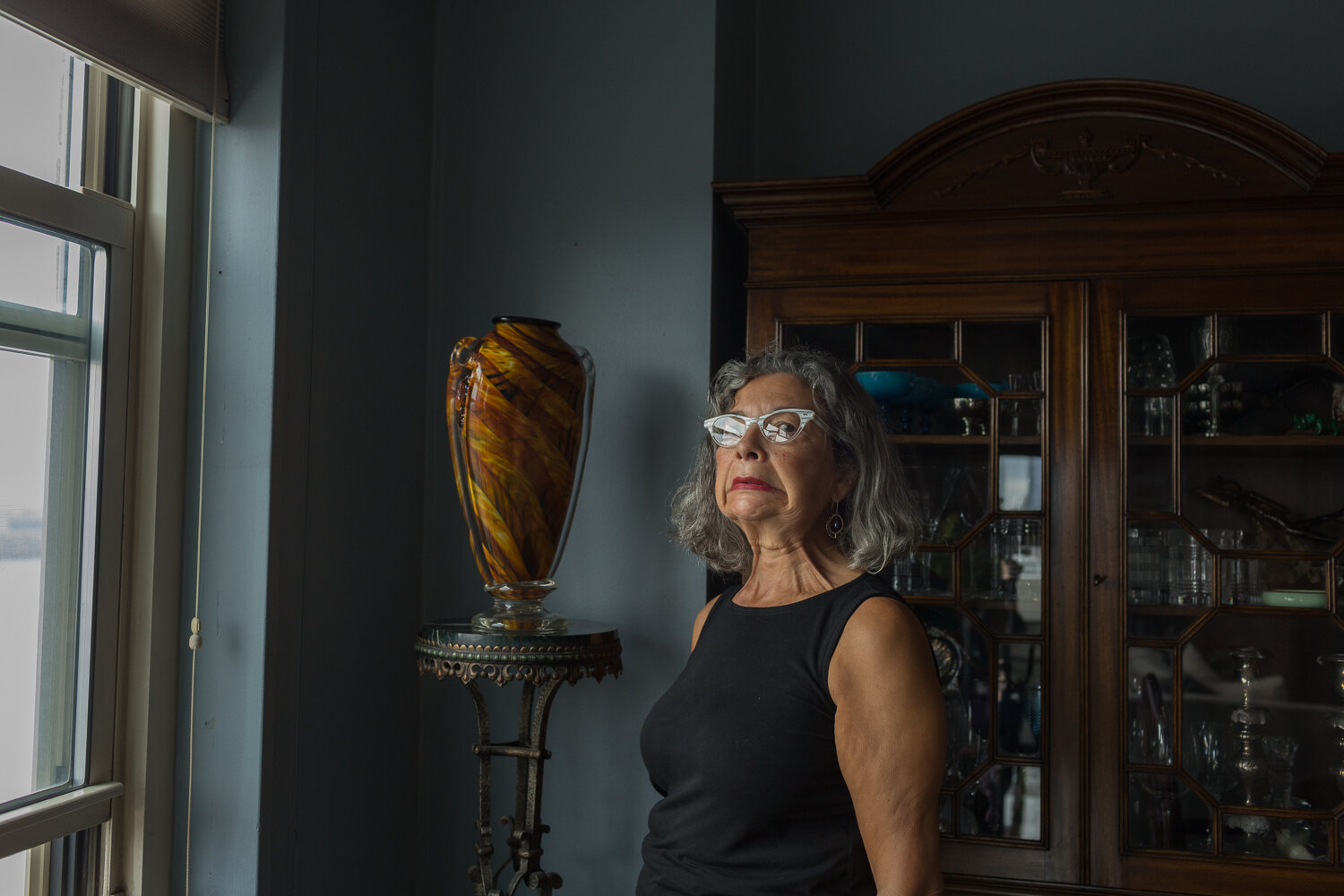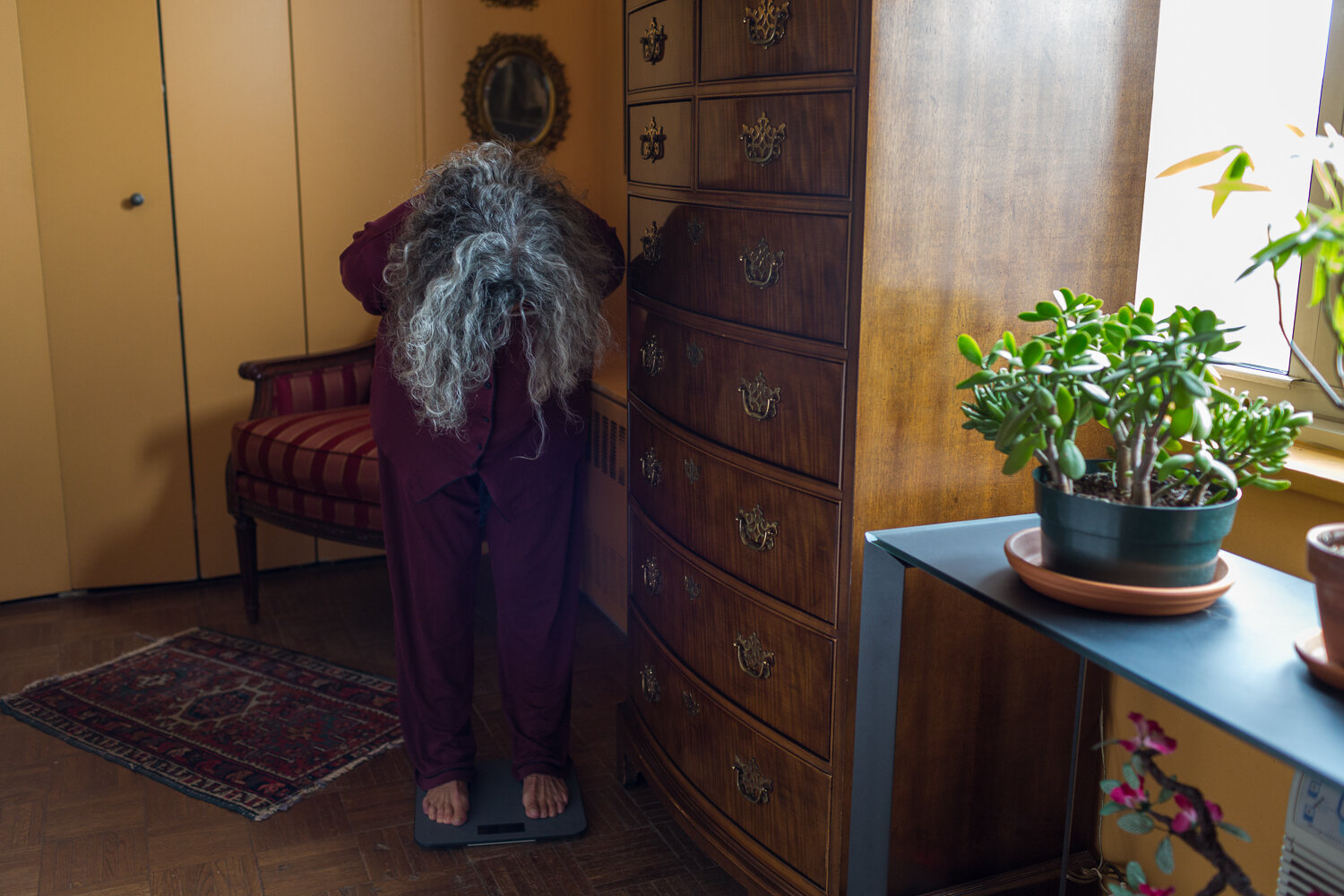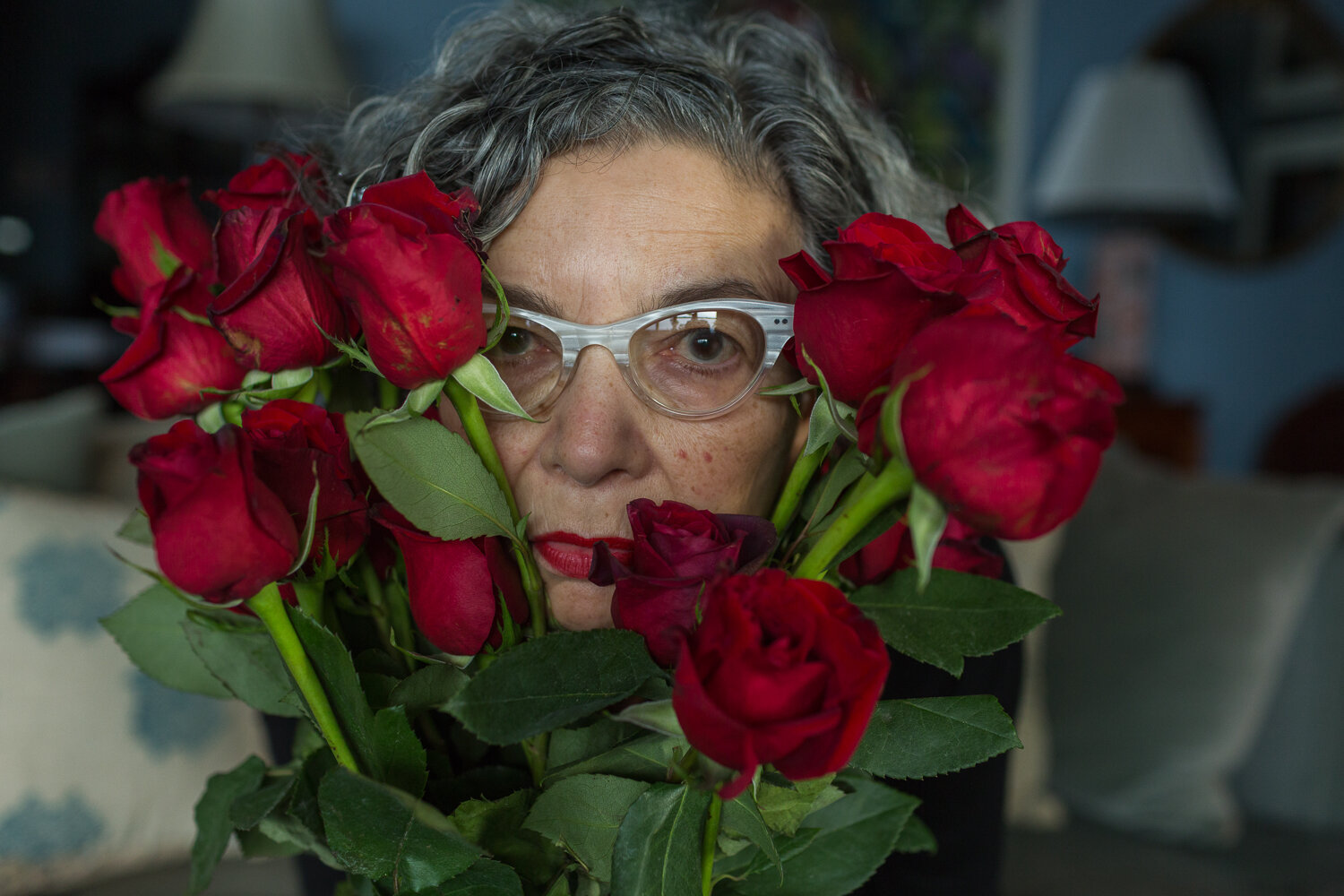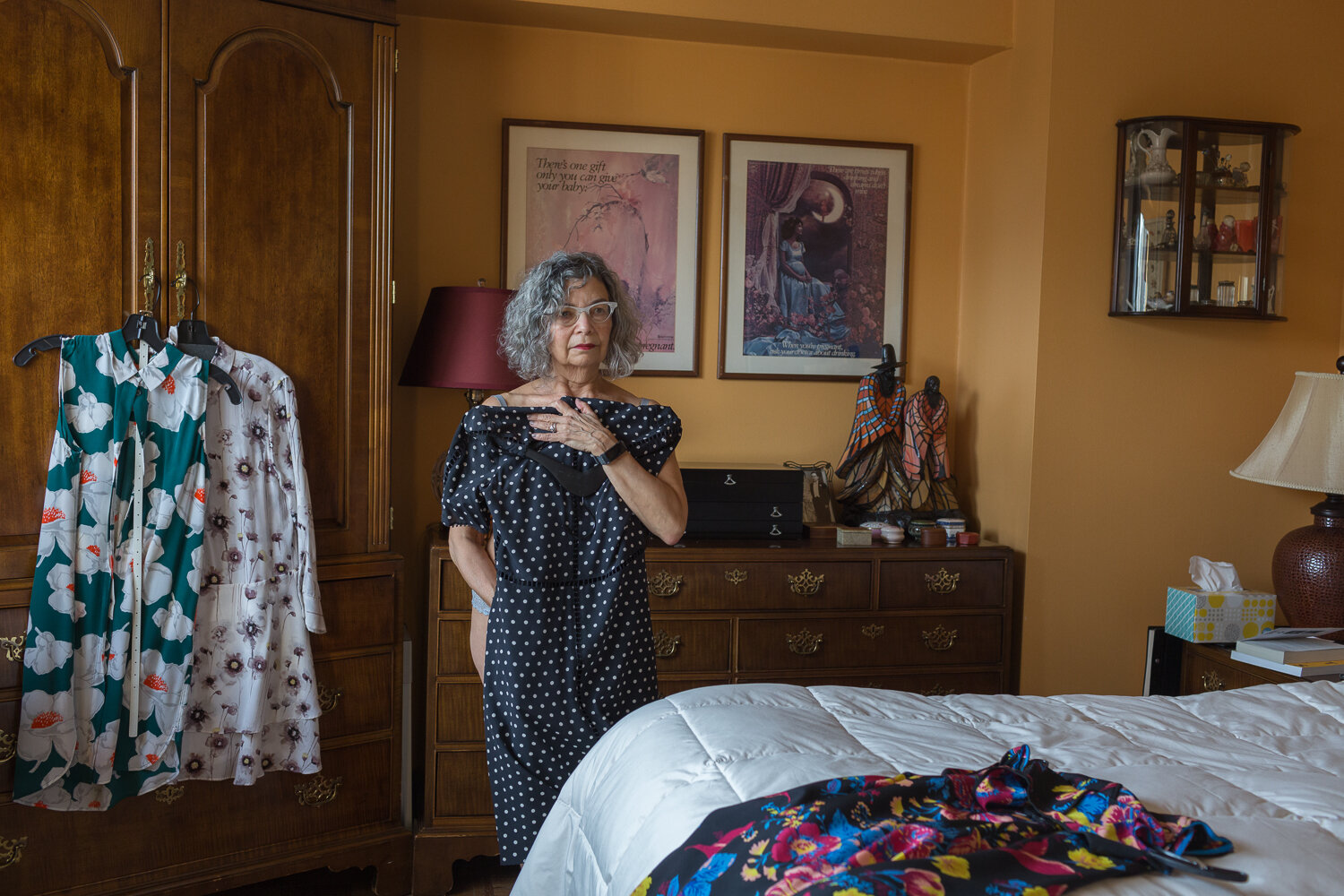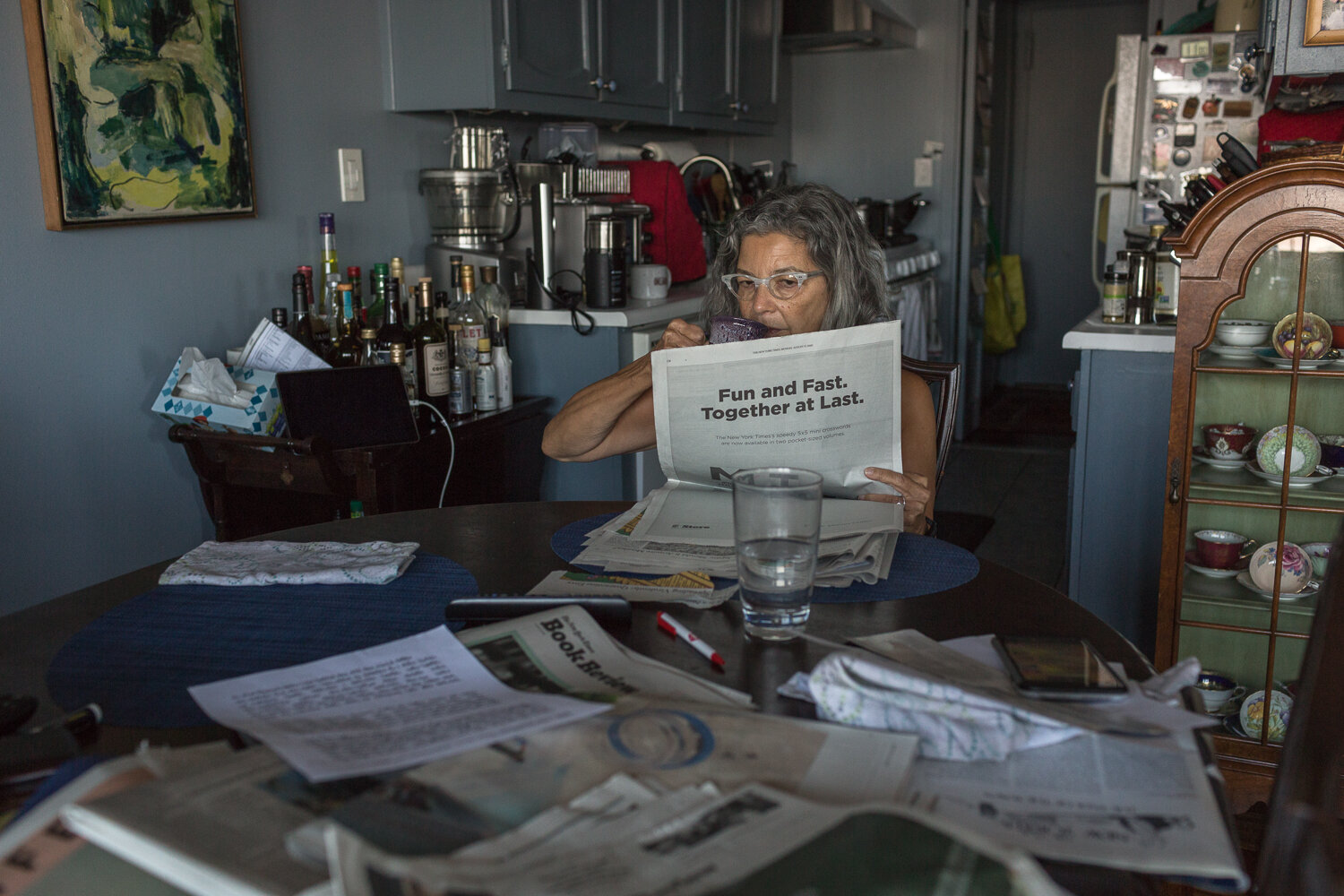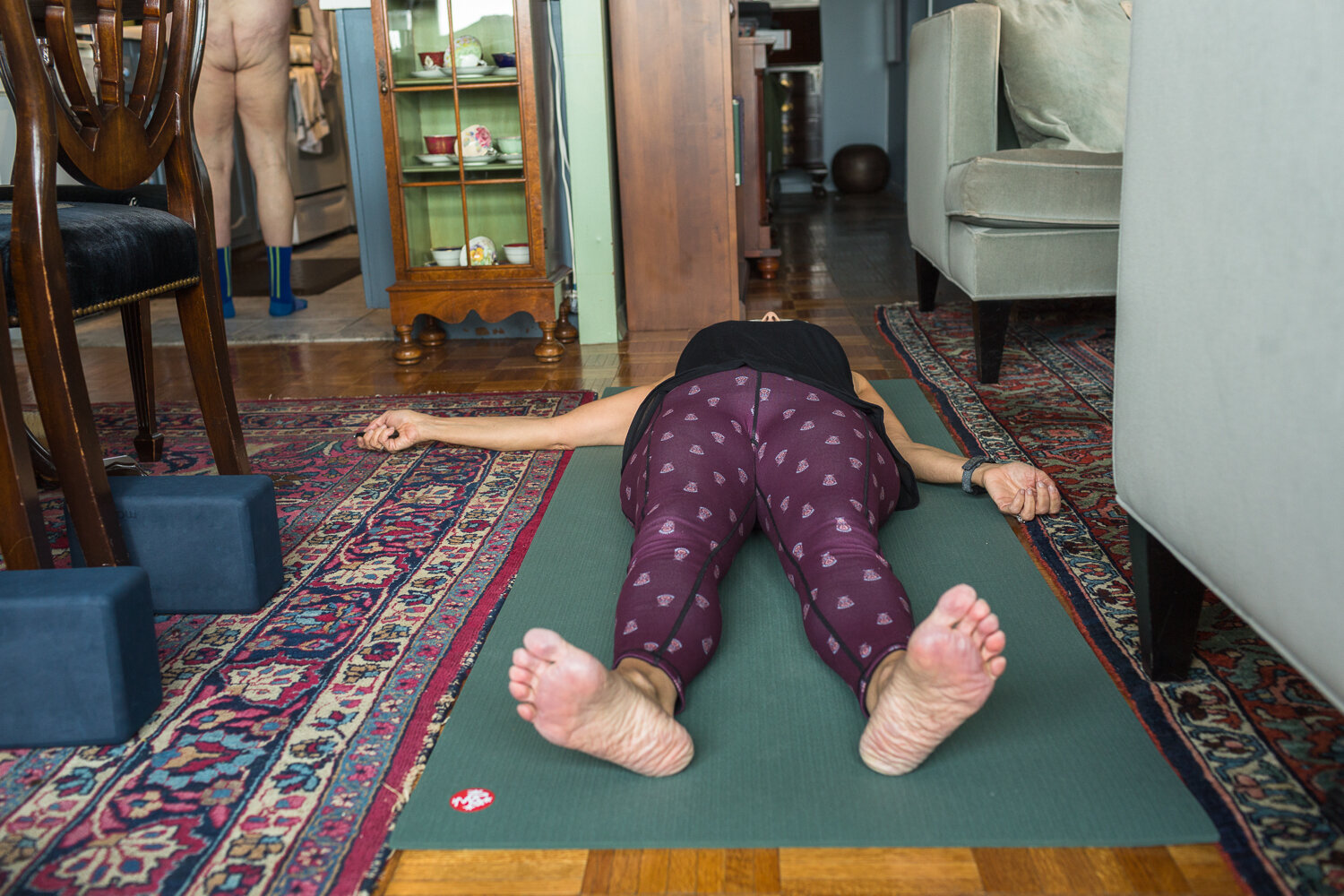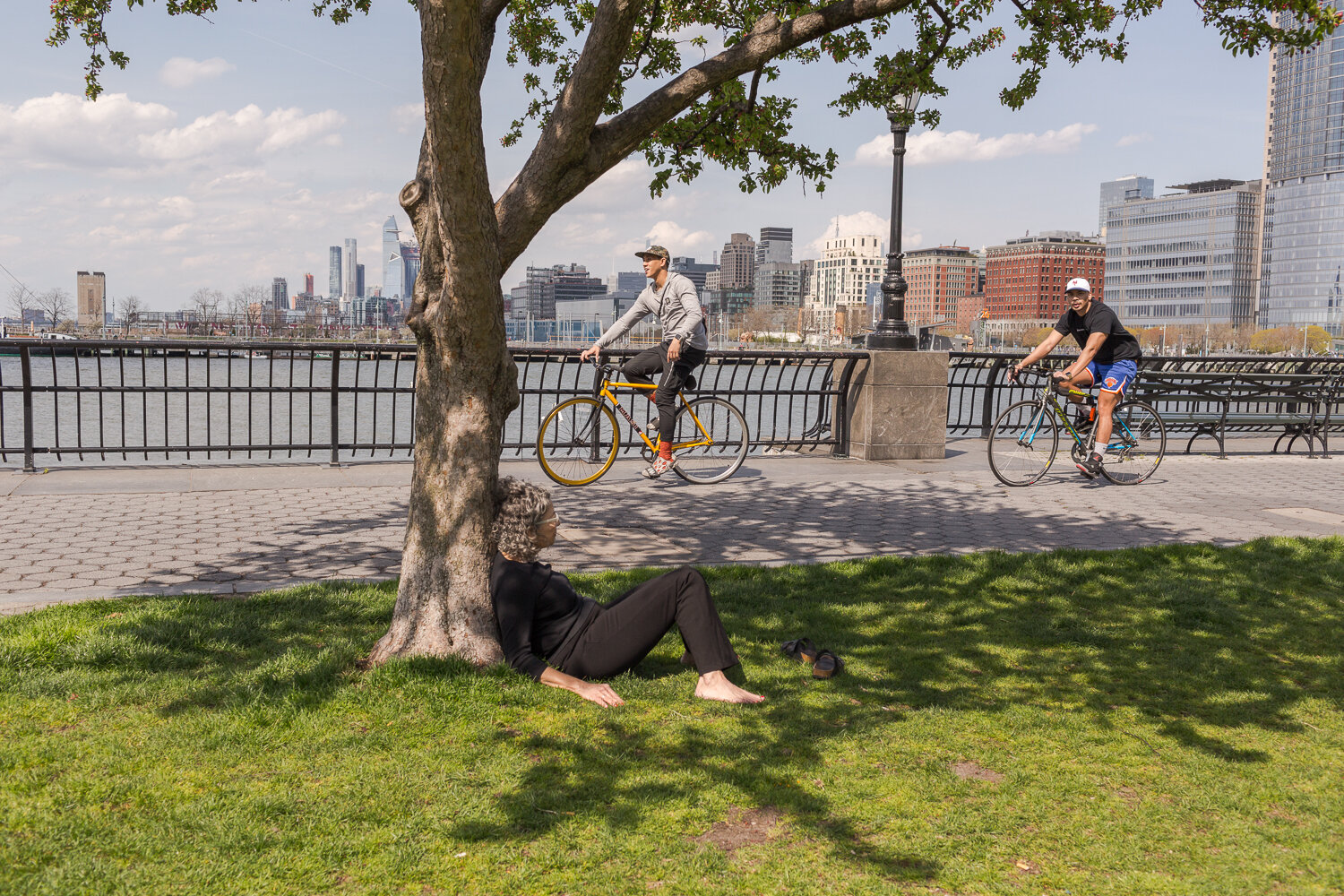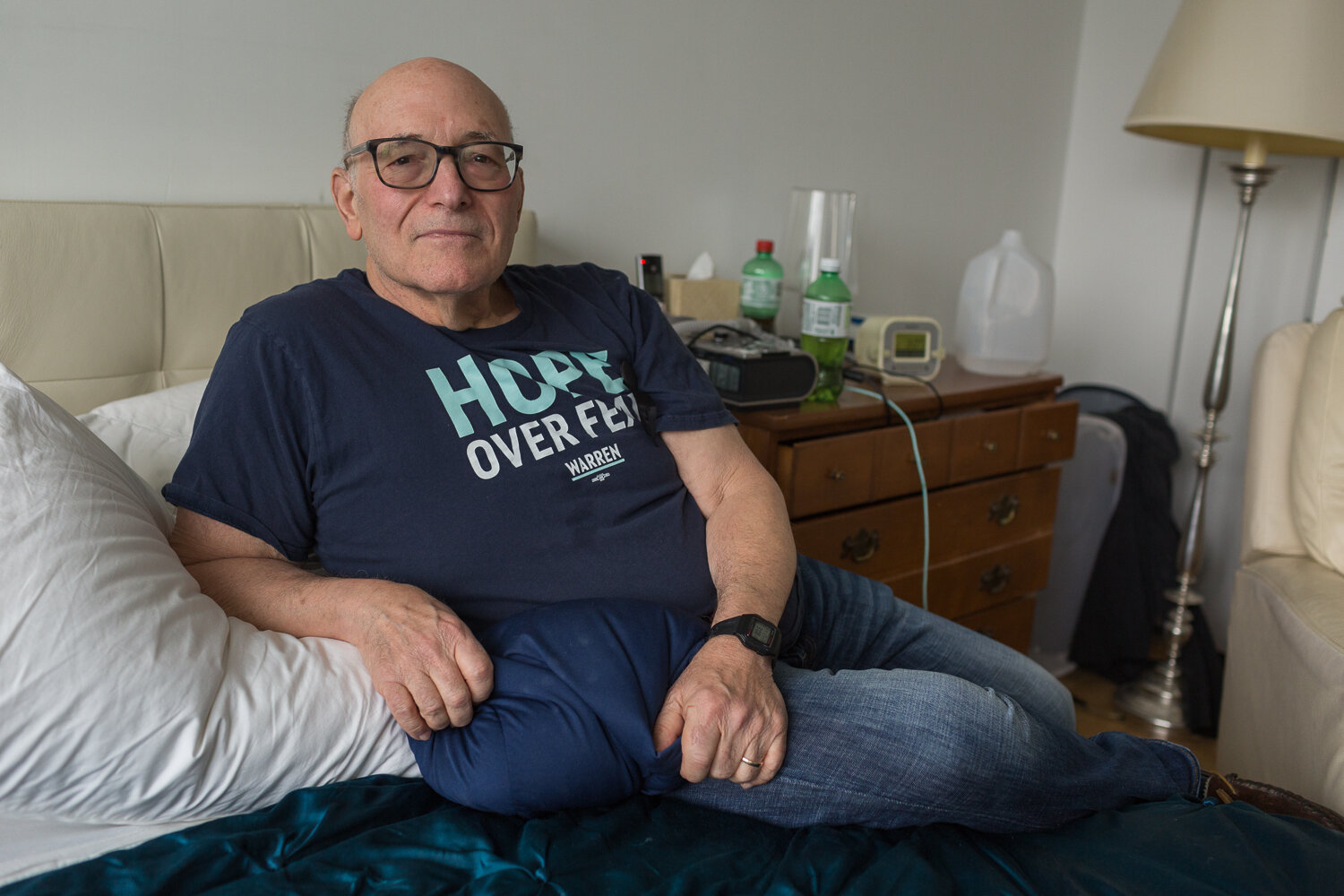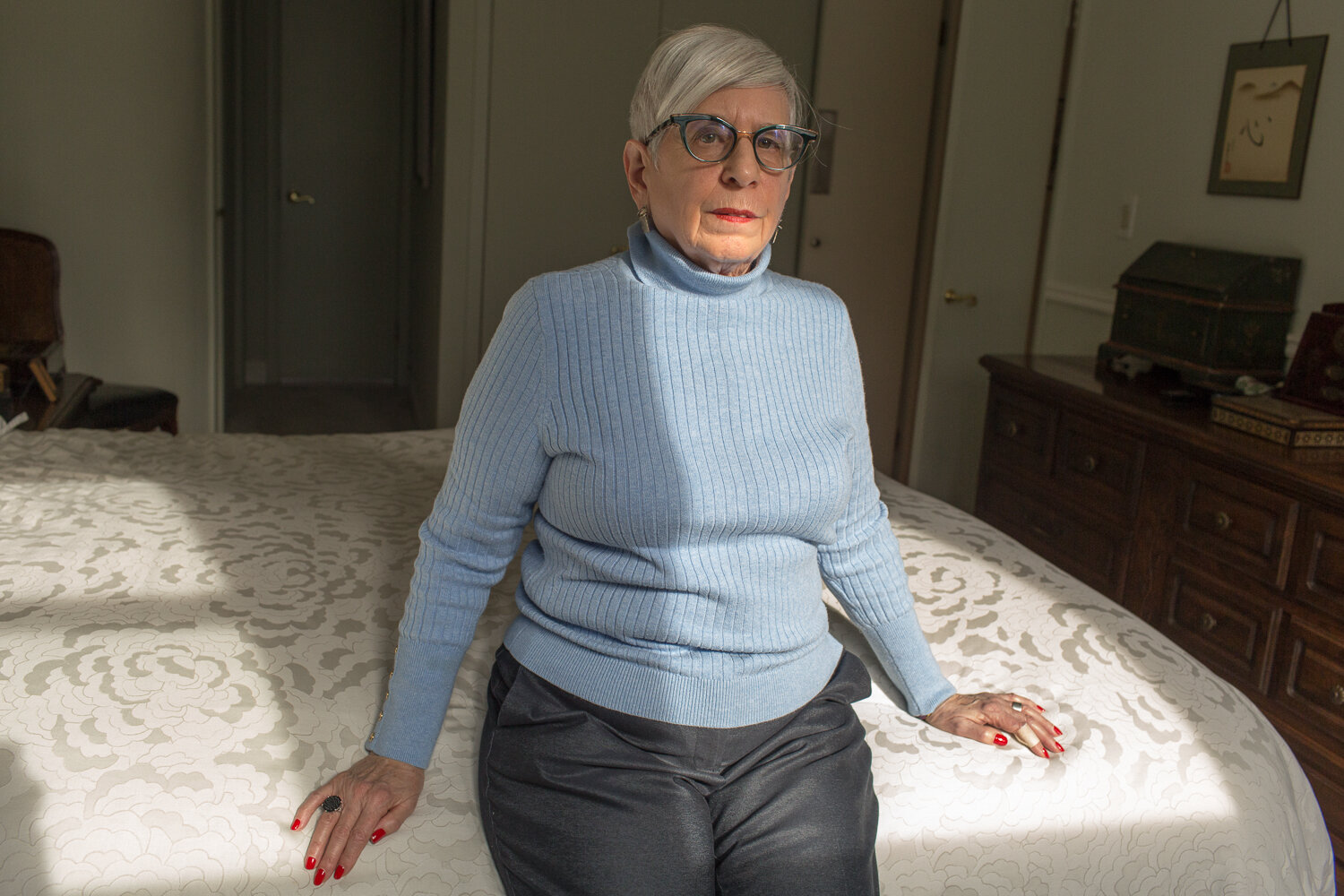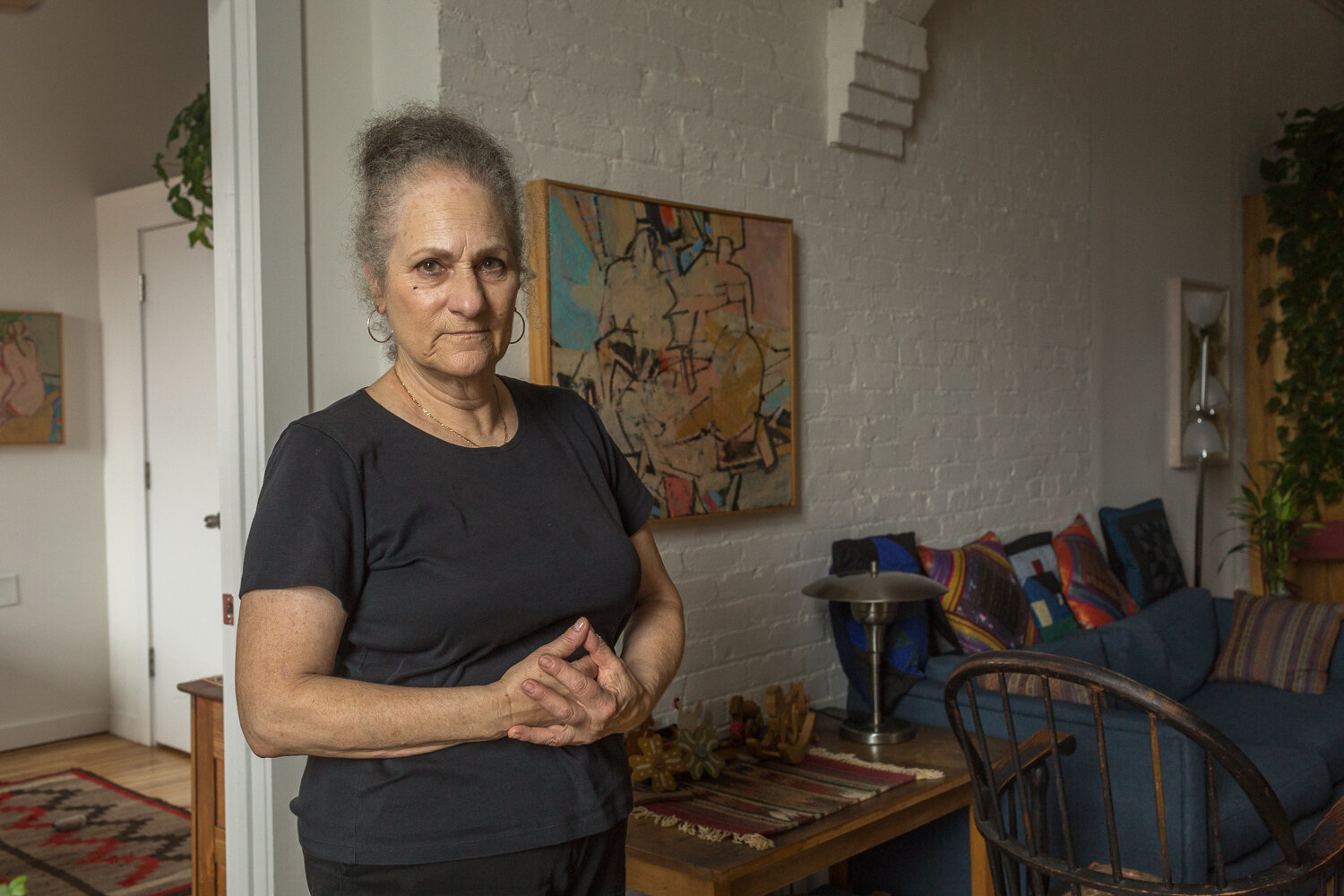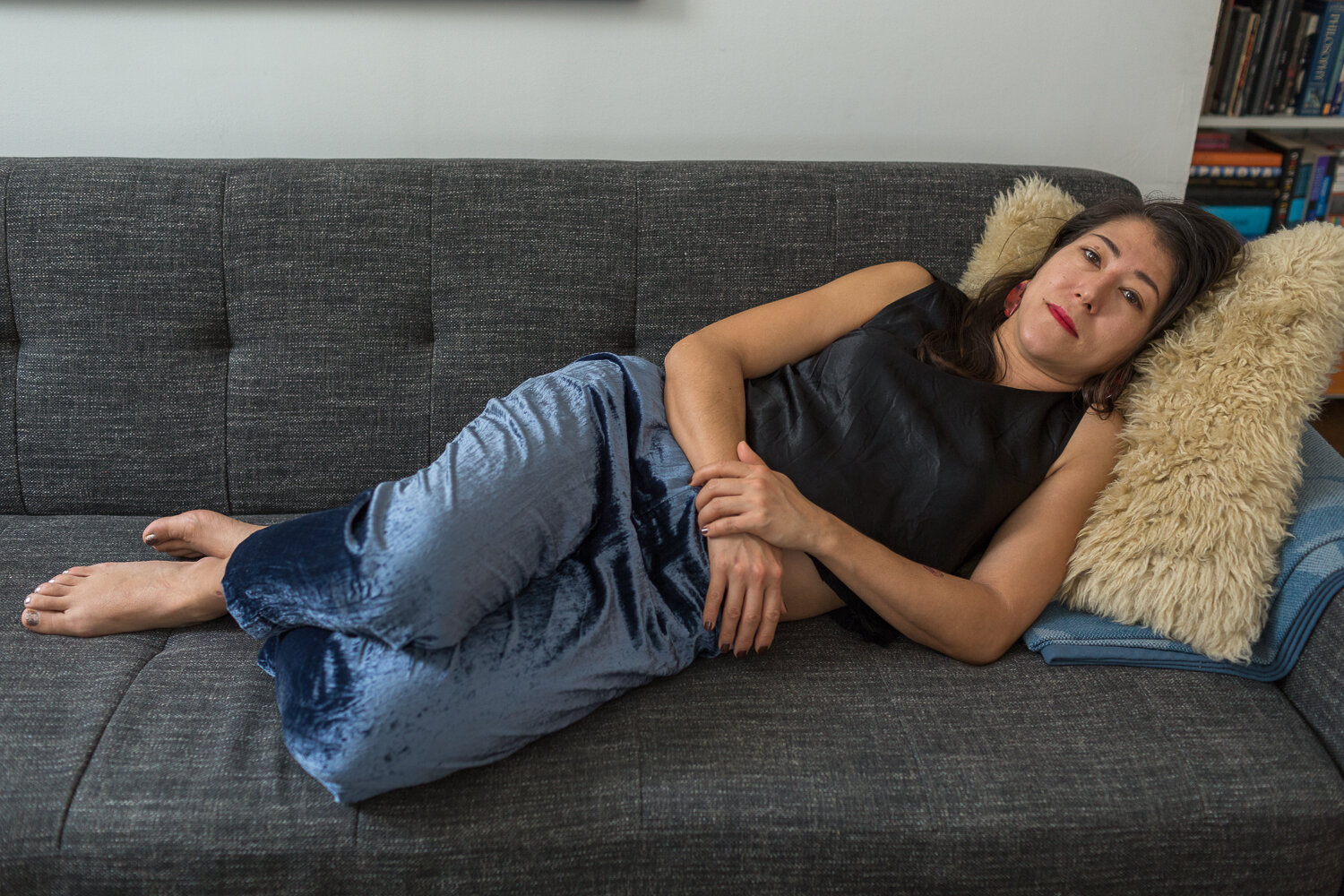Q&A: Susan Rosenberg Jones
By Hamidah Glasgow | June 17, 2021
Susan Rosenberg Jones
Susan Rosenberg Jones's passion for photography has been a lifelong endeavor. Her images reflect the curious and joyful person she is, and the humor, insight, and awareness she brings to the work help us see ourselves anew. Jones's work during COVID is an honest insight into one person's life during lockdown.
With my artistic practice, I explore themes of home, family, identity, aging, love, and relationships. Working mostly in color I meet my subjects in the environment where they are most comfortable, usually the home, to tell their stories with authenticity and compassion. At times, I use a lighter touch, occasionally injecting humor, to express intimate feelings about the person being photographed, especially if it’s someone close to me. I am influenced by literary fiction in terms of character development and place description, and I endeavor to create images that touch on human emotions that are recognizable and familiar.
HG: Susan, Thank you for taking the time for this interview. As you know, I’ve been familiar with your work for quite some time. I don’t know your story, though. How did you get started on this artist path?
SRJ: Thank you, Hamidah! I became enchanted with photography as a young child. In my family’s ranch-style house in Boston, I used to sit on the floor and peruse their many books on the lower shelves. Among the books was a collection of digest-sized Coronet magazines from the late 1930s-40s. Each issue had an art or photography feature. The photography was a mix of everything from social documentary, á la Lewis Hine, to celebrity portraiture by David Seymour and others – all in black and white. I loved the portraits especially, the shimmering black and white, the light, the drama!
Later, when I was about 9, a neighbor woman who was an elementary school teacher remarked on my practice of walking around the neighborhood with my family’s Kodak Brownie camera, taking pictures. Soon after, she gifted me with a “how-to” book on photography basics. I devoured that book. Apparently, the chapter on portraiture rang a bell. I still remember setting up my first serious shoot in my living room, photographing my little brother and the teacher’s daughter in dress-up garb.
Then one day, when I was a young teen, I was engaged in a session of gravestone rubbings with my friend Emily in a graveyard in Cambridge. A teen boy approached us, camera around his neck. He told us about a place called the Boston Film Center where a man lent cameras to kids, taught them how to develop and print. I found myself there soon after – pun intended! I fell in love with making photographs with intention, taking charge of the process, and producing prints. It was magic.
I chose an education major rather than formal art school for college but continued to practice and study photography. In my mid-20s - in 1976 – I moved to NYC and enrolled in the photography department at the School of Visual Arts as an undergrad since, at that time, they didn’t offer an MFA. There were other college grads like me in that program as well. I loved my classes and teachers and left after a couple of years, deciding that I wanted to be out in the world and didn’t need a second bachelor’s degree. I took a job as a custom black and white printer at a lab, and my skills were such that I was promoted to head printer. I loved printing.
Then my husband and I decided to have a child. After I returned to work when my daughter was 17 months, I began working in the stock photo industry – I was a photo researcher, photo editor, licensing specialist. I worked in that career for 34 years. My husband was a musician, and we figured one of us needed a stable job with health benefits. During those years, I was always making photos but moved from black and white to color chromes, and finally, much later, to digital. One thing I loved about my job was that I was constantly looking at images and making decisions about them. Even when I wasn’t shooting, I was looking at photographs in a critical way.
My husband was very ill for a few years leading to his death in 2008. I didn’t shoot that much during that time; I was overwhelmed with stress. In early 2009, I bought a digital camera and started taking Continuing Ed classes at the International Center of Photography. Most of the classes were in the Personal Vision category, and I was in love with the practice again.
In 2016, I decided to quit working full time since I would be qualified for Medicare that summer. I wanted to have the freedom to expand my photographic practice without the constraints of a demanding job.
Since then, I’ve been steeped in various series and projects, all revolving around intimate and environmental portraits of home, family, community, and self.
HG: I’m loving the self-portraits that you have been doing during the COVID Pause. Please tell me about these. Their origin, how you create them, what you’ve learned from doing them, and where they are going now. They are so full of insight, humor, honesty, and a great sense of who you are.
SRJ: One day in July of 2020, during the lockdown, I was sitting on my balcony staring into space, bored, daydreaming. I suddenly got the urge to see what that looked like – as if I were observing myself in this listless state. I set up the tripod, assumed my position, and, thanks to a remote, made some pictures. I attempted to catch myself as I really was there, in that state of being. Of course, there’s a performative aspect, and I tried to make an interesting picture in camera.
I enjoyed the experience, so did another, and another, and continued. I was trying to make sense of the mild depression I was feeling from being stuck at home, worrying sick about the political situation, the global crises, and the COVID body counts. Some of my portraits showed my despair, and what I was doing to stay positive. Others focused on my self examination as an aging woman, since I had so much time on my hands to obsess about these things.
Daydream
When I photograph other people, I choose the location, find the light, move around to blend subject and background. But photographing myself, I first must identify a certain attitude or feeling, and then figure out how I can show that in a photograph. If it’s not super specific, it won’t work. I can’t help but see humor in certain situations. I don’t force it, but some situations are funny. Also, I didn’t realize how much I enjoy performing for the camera – I guess there’s an actor in me somewhere.
Throughout 2020 I illustrated scenarios where I was reacting to and managing all the stresses of the year; beginning on January 20, 2021, my portraits shifted a bit as I became more hopeful. Now, having been vaccinated since March, I’ve been photographing people again sans masks. I still plan to continue with the self-portraits but am waiting for the right situation to hit me. Once it does, I’ll ruminate awhile on the set-up. I’m looking forward to that inspiration as it’s a joyful experience making these images.
HG: The widowed work is brave on your part and the part of the sitters. There is a strange societal association with being widowed. I don’t know that I can put my finger on what that is; it’s just a feeling that I have. Perhaps, you can elaborate on that?
SRJ: Yes! It is strange. Several of my sitters have talked about how other people made them uncomfortable in their discomfort in approaching them. People are confused as to how to speak to someone who has lost their partner.
And then there are these strange unwritten societal “rules” about how soon it’s appropriate for a widow to go on a date, take a class, attend a party, travel, etc. My sitters who had the best experiences in terms of others are those for whom people said, “I’m here for you,” and/or left cookies and other goodies on their doorsteps – respecting their space to deal with their grief yet being available to them.
There’s a stereotype of the widow in black, bereft, and alone. Or the idea that widowers are lost without a woman and the first to remarry. I can say that there is no one way for this. My sitters - and myself – have dealt with the loss in every possible way.
HG: What have you learned about people who have lost someone they were married to? Is there a question that is common amongst your sitters? Or a realization?
SRJ: One of the most satisfying aspects of this project is that the sitters enjoy their conversations with me. Whether they’ve lost their person recently, or a while back, even years ago – they appreciate this opportunity to talk about their feelings.
It stays with you forever. I’m happily remarried, but I still have painful moments remembering my late husband. Here and there, I’ll have a good dream where he’s present. So – I enjoy the conversations with my sitters as much as they do. And they confide in me because they know I’ve been there.
There is consensus amongst my sitters that it’s best to allow one’s friends to take care of you if they offer. A couple of them had told me that they were too shy to accept help and regretted it later. Off the top of my head, that’s the most frequent advice my sitters share.
HG: Does your project include long-term couples that hadn’t married? Maybe because until recently they couldn’t? (LGBTQ couples)
SRJ: Yes –my first widower was Darrell, who lost his long-term partner of 25 years, Roger. They weren’t legally married.
Another sitter, Ellen, is remarried now, but she lived with her late partner for ten years. They weren’t legally married.
Ronnye was with her partner for 20 years. He died a couple of weeks before their wedding.
And finally, Edward was with his partner Neil for 58 years. They never married.
HG: One thing that we attain with age is wisdom and an understanding of the long game. Please talk about how those affect the work that you make now.
SRJ: Ha! I can’t believe that I turn 70 this summer – am I now considered elderly? Well – there’s nothing I can do about that.
Seriously – I enjoy getting older because there is that wisdom and appreciation of the long game. I perceive current trends in art photography, and while I appreciate a lot of the work, my age and experience has taught me not to jump on every bandwagon. I can only do what I can do. I’m steeped in my intention to make pictures that are authentic and tell a story simply.
I enjoy exploring every aspect of life as it unfolds as I grow older. I love seeing my friends and peers develop skills, interests, and confidence as they mature, and have started making portraits of certain people who are what I consider self-actualizing.
My widows are different ages, but most of them are older. So it’s gratifying to hear them tell me of how they are taking stock and reinventing themselves.
HG: What are your hopes and dreams for your work in the future?
SRJ: My hopes and dreams for my work are modest, I think. First, I hope to stay healthy. Making photographs gives me a lift, and I wish to continue my practice well into older age. I’m pretty sure that one of my favorite photographers, Helen Levitt, photographed in her 90’s. So that’s what I hope for myself.
I’m looking forward to continuing the self-portraits, especially as I navigate the challenges of aging. And since I believe strongly in the power of the image to nudge social awareness and change, it would be nice to contribute to a general understanding of the value that our elders can bring to the table.
Making portraits brings me closer to people and communities. I want to keep doing what I’m doing.
Anything commercial would be a nice byproduct but not necessary. I don’t have a driving need to make a book, although the Widowed body of work would make a nice book that might help people experiencing the death of a spouse.
HG: My sense of you is that you are a very joyful person. Where does this joy come from, and how do you maintain this state?
SRJ: I had to call my brother for this one – just to make sure his memories and mine concur. He remarked that ours were the only parents we knew of who bought Mad Magazine and encouraged us to read it. Indeed, we had a little table in the bathroom for reading matter – Mad Magazine was always there. My father was scholarly and reserved, yet he had a wonderful dry sense of humor and loved making wry statements and waiting for the laughs. My mother had infectious joie de vivre. I’m sure that between nature and nurture, my upbeat attitude comes from them.
I enjoy being home and hibernating, but I also love being with people, meeting new people, communicating. I see the glass half full for sure. “Not working for you? Try Plan B!”
I am more intuitive than intellectual and try and maintain a life with as little stress as possible. If I have something stressful going on, I’ll do what needs to be done to alleviate it. I exercise a lot, and I’m sure that helps – I believe in the body/mind connection. I tell my loved ones I love them every day. I know I’m lucky to have loved ones.
HG: Thank you for your time and insights.
SRJ: Thank you!
Signs Of Spring
All images © Susan Rosenberg Jones



